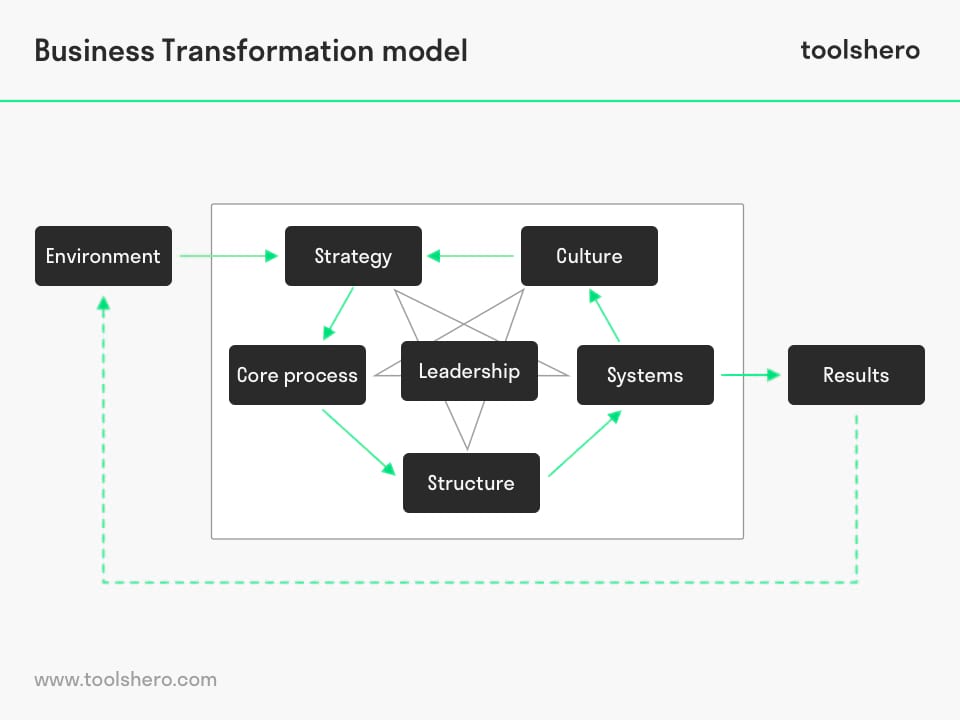Business Transformation Strategy and Model

Business Transformation Strategy and Model: this article provides a practical explanation of Business Transformation Strategy and Model. Next to what it is, this article also highlights why these are necessary, what operational transformations are and how do I implement these, including a Business Transformation model. After reading, you’ll understand the basics of this strategy tool. Enjoy reading!
What is Business Transformation?
Business Transformation is a concept with a lot of different definitions. To some, Business Transformation is synonymous with change management; a strategy that involves aligning people, processes, and technology with the company strategy.
Others describe Business Transformation as an umbrella term for implementing changes to business operations. In this form, it’s also about personnel, processes, and technology. Transformations are often done to make organisations more effective, efficient, and larger.
Reasons for implementing Business Transformations are to unlock the potential of employees, intellectual property, end owned technologies to use it for additional objectives and becoming more efficient.
Business Transformations in larger companies are often big, multi-year initiatives. They cause change on a large scale and often require major changes to the basic characteristics of a company. Because of the impact and scope of such transformation, they’re directed from the top.
The scope is broad and strategic, such as changing operational or business models. The upper management, whether it’s the CEO or board of directors, has the goal to position the company in such a way that it will continue to grow and be successful in both the near and distant future.
Why are Business Transformations necessary?
Business Transformations are generally answers to issues. First of all, many organisations have underlying problems or causes of organisational inefficiencies and other hurdles. These have to be addressed.
In addition, there’s the upper management and main shareholders’ desire to take the opportunity to address these problems in ways that can sometimes fundamentally the organisation’s vision.
The need for transformation can also be caused by external changes (threats and opportunities), such as products or services being outdated, changes to investment flows, complying with new laws and regulations, or making the organisation more competitive.
The management approach for change is supported by Business Process Re-engineering (BPR), for example. Other methods, such as Six Sigma or Lean are more focused on the step-by-step implementation of change, rather than a radical shift. Other reasons for Business Transformations are:
- Increasing turnover or market share
- Increasing customer loyalty
- Reducing costs
What are the different types of business transformations?
Scott Anthony divides business transformations into three types:
- Operational transformations
- Transformations in operational models
- Strategic transformations
In addition, we can distinguish between a number of other types of business transformations:
- Business process transformations
- Digital transformations
- Management transformations
- Cultural transformations
In the rest of this article, we delve deeper into these different types of Business Transformation.
What are operational transformations?
Operational transformations are about improving what an organisation does and how it does this. There is a desire to do what the organisation does better, faster, or cheaper. Companies for whom digitisation is an important pillar often fall into this category. They use new, innovative ideas and technologies to resolve existing problems.
Although an operational transformation can be comprehensive and highly impactful, it is not a clear change of the structure, nature, or appearance of an organisation. Through operational transformations, it’s possible to achieve cost reductions, as well as increase customer loyalty, but the essence of the company remains unchanged.
What are business process transformations?
Transforming business processes also falls under this category and type of Business Transformation. This transformation is mainly aimed at optimising and automating repetitive processes.
This lets the organisation focus on more valuable business processes. The end goal it to unburden the company where it’s possible, allowing it to innovate or offer other services, so that the consumer gets more value.
What are digital transformations?
Digital transformations are specifically aimed at the use of technology and digitisation to add more value, either direct value for the consumer, or added value for the organisation through costs reductions or increased efficiency.
An example of digital operational transformations is the implementation of a digital CRM system. This makes it possible to gather and manage data in an automated way.
What are transformations in operational models?
Transformations in operational models are also called core transformations. This means that the organisations make a complete turnabout in how they do things. Netflix is a great example of a company that has transformed its operational model.
Netflix switched from DVD rentals by post to the online streaming of films and series. They also made a radical turnaround in what they were offering. When they started, they offered content created by others. Today Netflix also produces its own content.
What are strategic transformations?
Strategic transformations are the most far-reaching transformations of all. This is transformation in the most literal sense of the word; it’s about changing the essence of a company.
The most successful companies excel at this. Apple, for instance, transformed from a computer company to a gadget company, Google went from a search engine to advertising and self-driving cars, and Amazon went from retail to cloud services. If implemented successfully, strategic transformation helps a company to grow.
What are management transformations?
Management transformations often include proactive changes to the direction or vision of the company and the executive management.
Management transformations are implemented to apply changes before they are actually needed, so that change becomes a regular part of strategic moves, instead of a response. During management transformations, it’s important that employees are sufficiently involved, motivated, and informed.
Motivation
One characteristic of management transformations is the ability to inspire and motivate followers (employees) to come together for a common cause. This is important because employees need to be confident about what direction the organisation is heading to.
During the transformation, it’s essential that the management uses the right buttons to keep up morale and make employees excited about the new objectives.
Vision
Management transformations often involve a change in the vision on how the company is run. In addition, it’s important that there is an ability to communicate this vision clearly. It’s often a challenge to coordinate the vision and strategy with employees on all levels.
What are cultural transformations?
Cultural transformations are in many ways the hardest to implement. This is because corporate cultures, like other cultures, evolve in an organic way, driven by leadership and reward systems.
Changing corporate culture takes a long time. In part because it’s hard to translate the beliefs, ideas, intentions and concepts of employees into policy and actions.
How do I implement a business transformation?
As with almost any processes in business, transformation starts with a strategy. Without clearly defined objectives and the bigger picture, any transformation is doomed to failure. The strategy has to be clear to lower-level employees as well. If that’s not the case, value is lost when ‘translating’ the transformation.
In addition, it’s important to identify the abilities that have to be changed or improved to realise the strategic objectives. These are abilities that the organisation currently lacks, isn’t good at, or that clearly need improvement.
Think about the following:
- The mission is derived from the strategy. It’s about the why, how, and what of a company.
- Supply of information. How is data gathered? How does the company communicate internally? How is information used for decision making?
- What rules apply within the company? What roles are important? Which responsibilities do various key employees have?
- Process capacity. How have the business processes been designed? Are they properly defined? (Business Process Mapping), are they suitable to achieve the desired results?
- Talent & personnel. What skills are required? Is specific expertise or experience required?
Any transformation requires endurance. Transformations aren’t started to be implemented poorly, causing the company to revert to its old ways.
Business Transformation model
The Business Transformation model is a framework that helps leaders and other users understand their organisation.
Basically, it’s a sketch of how the organisation works. It’s essential in order to successfully develop and implement a redesign.
The model reduces an organisation’s activities to the eight most important umbrella elements that have to be understood.
These are then aligned to turn the company into a smoothly operating whole. The better these eight elements are aligned, the faster insights can be formed about how improvements can be implemented in quality, efficiency, costs, profitability, or customer and employee satisfaction.

Figure 1 – Business Transformation Model
1. Environment
Organisations put in a lot of effort, like with other active systems, to operate in harmony with their external environment. This external environment changes rapidly, resulting in both threats too and opportunities for the organisation. An example of external changes is the changing needs and perceptions of customers.
Changes in the external environment are also stimulated by technologies, competition, laws and regulations, social influences, political influences, and the natural environment. Most companies strive to incorporate change into their strategic policy, so that they don’t have to adopt a responsive attitude towards their environment.
2. Core processes
The core processes make up the organisation’s workflow. They indicates the order of events and steps required to offer a product or service to the consumer.
Technological solutions are also part of this (devices, software (i.e. a workflow app, etc.) The core processes together are like the organisation’s beating heart, around which all other processes should form.
Understanding and streamlining processes (Business Process Mapping & Management) is the central task of any organisation.
3. Strategy
The strategy consists of multiple elements. Firstly, strategy is a series of conscious activities and decisions about how an organisation adds value and sets itself apart from the rest of the market. Strategy also has both a performance and growth aspect.
A well-developed business strategy tells everyone where they’re heading to based on the strategy, essentially steering the organisation like a ship’s rudder. The strategy adds personality to an organisation, along with the corporate culture. A clear and motivating organisational strategy helps a company to transform from an ordinary office to a place where people are inspired to deliver their best.
4. Structure
Structure says something about how people are organised around the previously mentioned core processes. It goes beyond job descriptions, responsibilities, or reporting between employees; it’s also about coordinating tasks and assigning resources. The aim should always be to align the structure with the objectives in such a way that it helps performance instead of impeding it.
5. Systems
Systems are activities or mechanisms that help organise the organisation. Examples of systems are recruitment and selection, training, planning, HR policy, performance management, etc. Systems are standardised as much as possible and are broadly implemented.
6. Culture
Corporate culture tells you something about how the organisation really works in terms of people and dynamics. It consists of leadership, the attitude and habits of employees, and different management techniques.
Together it makes up the distinctive personality of an organisation. This permeates into everything and is both the cause and effect of certain behaviours. The culture reflects the organisation’s values and vision.
7. Results
An organisation’s results determine its success and financial health. In the context of business transformations, performance is often the leading factor for implementing a transformation. In the end everything is about results. Having no clear picture of the results, both current and future ones, is like a ship adrift at sea.
8. Leadership
Leaders influence the level of success of a company. They set objectives, monitor results and processes, define and adapt strategy, develop people, and build the corporate culture. Successful leaders constantly realign their assumptions on work, organisations, and people to build a collaborative and proactive organisation.
Now it’s your turn
What do you think? Are you familiar with the explanation of Business Transformation? Have you ever experienced a Business Transformation? Do you think your company should implement a transformation? What do you think is important to keep in mind when engaging in Business Transformations? Do you have any other tips or additional comments?
Share your experience and knowledge in the comments box below.
More information
- Koehler, J., Hauser, R., Küster, J., Ryndina, K., Vanhatalo, J., & Wahler, M. (2008). The role of visual modeling and model transformations in business-driven development. Electronic Notes in Theoretical Computer Science, 211, 5-15.
- Mirvis, P. H., Ayas, K., & Roth, G. (2003). To the desert and back: The story of one of the most dramatic business transformations on record. John Wiley & Sons.
- Safrudin, N., Rosemann, M., Recker, J. C., & Genrich, M. (2014). A typology of business transformations. The 360º Business Transformation Journal, 2014(10), 24-41.
How to cite this article:
Janse, B. (2020). Business Transformation Strategy and Model. Retrieved [insert date] from Toolshero: https://www.toolshero.com/strategy/business-transformation/
Original publication date: 01/24/2020 | Last update: 11/20/2023
Add a link to this page on your website:
<a href=”https://www.toolshero.com/strategy/business-transformation/”>Toolshero: Business Transformation Strategy and Model</a>












